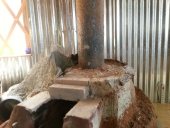
 3
3




 6
6




 3
3




 3
3




 6
6




Rocket surgeon and soil builder... healthy plants are all about the soil.
- My 6" Batch Rocket specs and materials list: https://permies.com/t/248275/Batch-Rocket-Double-Skin-Bell
- Batch Rocket detailed build thread with Q&A: https://permies.com/t/238503/Batch-Rocket-Build
 2
2




 2
2




 3
3




carol othdac wrote:plus, the bricks have been used and have some wear and tear, so are not pristine. I will need some good mortar solution for those parts if nothing else. Plus I'd like some inherent stiffness/structure for at least the burn box and tunnel, as this may end up as a single skin with no protective outer shell.
 3
3




![Filename: 2024-01-10-12-57-46-Brick-Bell-Laid-as-Shiners-(rocket-mass-heater-forum-at-permies)-Mozilla-Firef.jpg
Description: [Thumbnail for 2024-01-10-12-57-46-Brick-Bell-Laid-as-Shiners-(rocket-mass-heater-forum-at-permies)-Mozilla-Firef.jpg]](/t/237638/a/230677/2024-01-10-12-57-46-Brick-Bell-Laid-as-Shiners-(rocket-mass-heater-forum-at-permies)-Mozilla-Firef.jpg)
 2
2




 2
2




 3
3




 2
2




 3
3




 2
2










|
Where does a nanny get ground to air missles? Protect this tiny ad:
The new purple deck of permaculture playing cards
https://www.kickstarter.com/projects/paulwheaton/garden-cards
|





